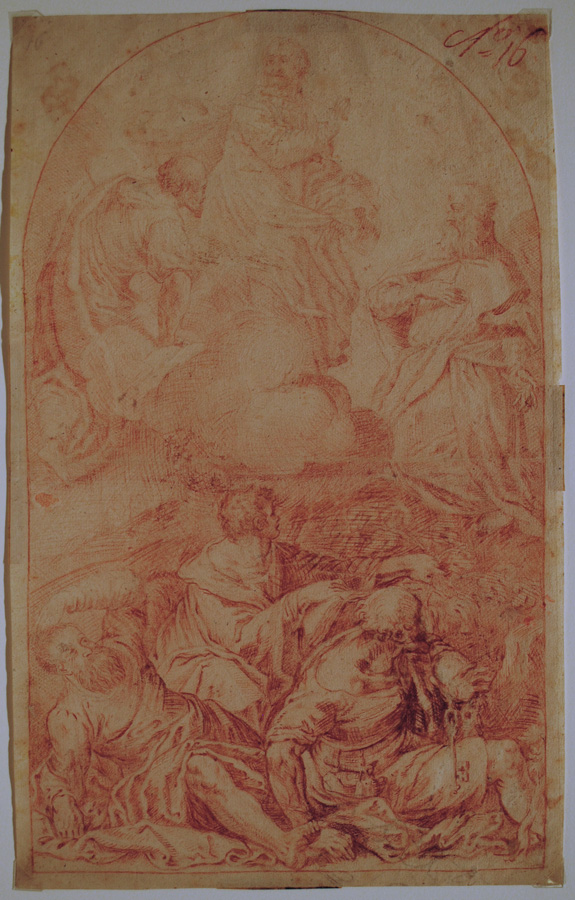|
The careers of Taddeo Zuccaro (1529-1566) and his brother Federico (c. 1542-1609) mark the transition from the Mannerist style, of which Taddeo was the last master, to the Baroque, which Federico helped to create. E. James Mundy suggests that by the time of Taddeo's death, the Counter Reformation had moved Italian artists from the playfulness, deliberate obscurity, and stress upon the discovery of a distinctive style or "maniera" to the creation of "clear, religious messages meant to stir the spirit" (p. 14). Taddeo, who was his brother's first teacher, was a Roman artist; Federico an international one, welcome at the courts of several popes, English and Spanish monarchs—Federico spent over a year in London, living in the house of the Earl of Leicester, waiting to see if Queen Elizabeth would assign him a major painting commission (she didn't) and painting her portrait and that of the Earl, among others—and the Doge and Senate of Venice. Mundy suggests that "while Taddeo might be said to revel in the local artistic dialogue, Federico would aspire, in his drawing, painting, and his theoretical works, to a visual form of Esperanto . . . equally at home in Rome, Venice, or Madrid" (p. 15). Unlike Taddeo, for whom, as for Michelangelo, the human body was the primary means of conveying meaning in art, Federico used the common language of symbols (undergoing codification in the manuals of the late sixteenth and early seventeenth centuries so that gentleman could understand the vocabulary of the new generations of artists). "When this language was decoded, it carried a specific meaning that spoke to a sophisticated, educated audience" (Mundy, 20).
Select Bibliography: Suzanne Folds McCullagh, and L.M. Giles, Italian Drawings Before 1600 in the Art Institute of Chicago (Princeton: Princeton University Press, 1997); Julian Brooks, with essays by Robert Williams, Peter M. Lukehart, and Christina Strunck, Taddeo and Federico Zuccaro: Artist-Brothers in Renaissance Rome (Los Angeles: J. Paul Getty Museum, 2007); Bonita Cleri, Federico Zuccari: Le idee, gli scritti (Milan: Electa, 1997); J.A. Gere, Taddeo Zuccaro: His Development Studied in His Drawings (Chicago: University of Chicago Press, 1969); Diane De Grazia, Corregio and His Legacy: Sixteenth-Century Emilian Drawings (Washington: National Gallery of Art, 1984); E. James Mundy, with the assistance of Elizabeth Ourusoff de Fernandez-Gimenez, Renaissance Into Baroque: Italian Master Drawings by the Zuccari, 1550-1600 (Milwaukee: Milwaukee Art Center, 1989); Sotheby's, New York: Drawings by Taddeo and Federico Zuccaro and Other Artists AND Life of Taddeo Zuccaro from Collection of British Rail Pension (NY: Sotheby's NY, 1990).
|
|
|
|
Taddeo Zuccaro (attrib.), The Transfiguration. Red chalk drawing on two joined sheets of thin cream laid paper. Watermark: Snake with a fleur-de-lys and the letters BB. Inscribed "No. 16" in red chalk upper right recto. A powerful presentation of this important event from the life of Christ when the Apostles Peter, John, and James suddenly saw Jesus clothed in light with Moses on one side of him and Elijah on the other. In the upper half of the drawing, we are in the realm of the visionary, blinded by the light of revelation; down below, where the three apostles are thoroughly grounded, the style reflects their earthy nature. According to Luke's account, Peter in particular, does not know how to respond to what is happening. Image size: 335x210mm. Price: Please call or email for current pricing information.
Part of a letter derscribing the response of an expert in appraising drawings: "The Transfiguration . . . is a Taddeo Zuccaro - there is no doubt in his mind. Zuccaro was one of many artists that were influenced by Michelangelo's way of creating a three dimensional sculptural experience on a flat surface in his paintings and drawings. For Zuccaro, the light parts in the figure work as frontal planes and then he would punch in depth with the dark tones. This was his way of forcing the 3-D aspect into the drawing. Michelangelo also used frontals but only on the figure and form, not on the space. Zuccaro would use the tone for the space between the form and figures as well as the architecture. The manner in which Zuccaro achieved his three dimensional effects was not duplicated by any other artist, for it is a style that is unique to him. . . . The drawing is just stunning and clearly it is the work of a master. Because it stylistically duplicates Zuccaro's approach to drawing it has to be by him because this way of working cannot be faked." (I have deleted the name of the expert until I can secure his permission to use it.)
|
|
|
|
Spaightwood Galleries, Inc.
To purchase, call us at 1-800-809-3343 (1-508-529-2511 in Upton MA & vicinity) or send an email to spaightwood@gmail.com
We accept AmericanExpress, DiscoverCard, MasterCard, and Visa.
We also accept wire transfers and paypal.
For directions and visiting information, please call. We are, of course, always available over the web and by telephone (see above for contact information). Click the following for links to past shows and artists. For a visual tour of the gallery, please click here. For information about Andy Weiner and Sonja Hansard-Weiner, please click here. For a list of special offers currently available, see Specials.
All works are sold with an unconditional guarantee of authenticity (as described in our website listing).
Copyright 2004-2017, Spaightwood Galleries, Inc.
Go back to the top of this page.
Visiting hours: Saturday 10:00 am to 5:00 pm and Sunday noon to 6:00 pm and other times by arrangement.
Please call to confirm your visit. Browsers and guests are welcome.
|
|
|
